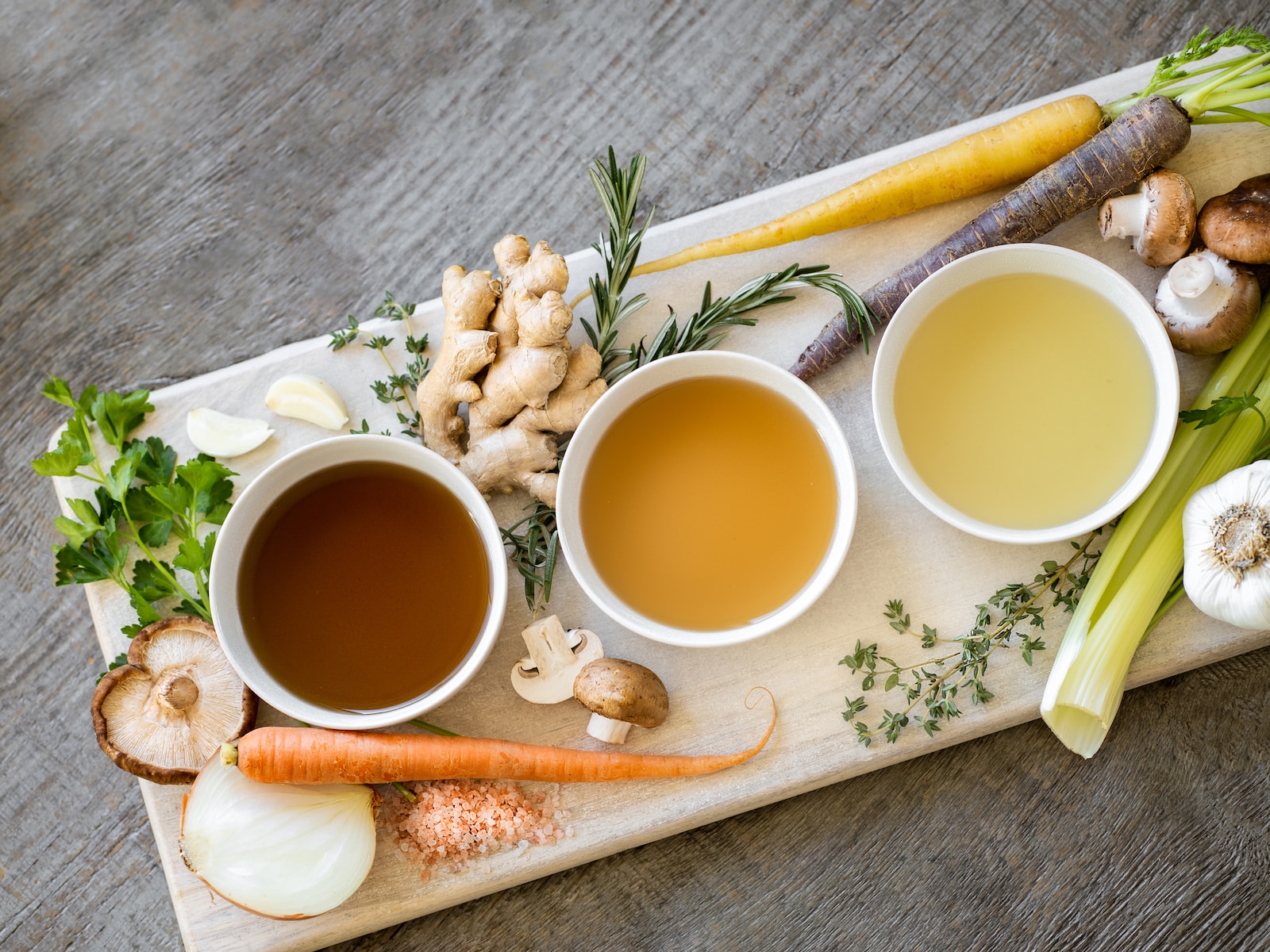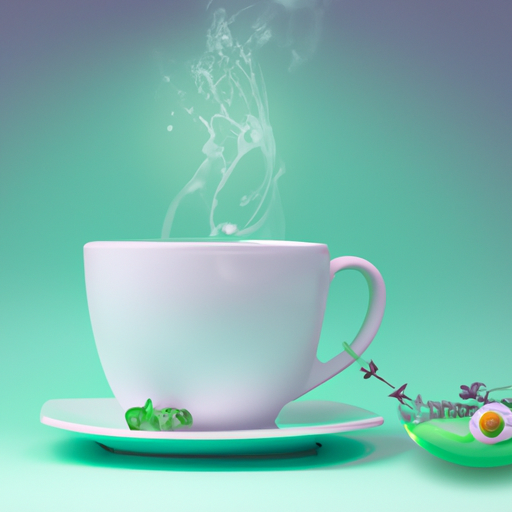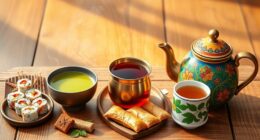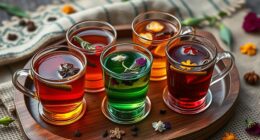Sipping on a soothing cup of herbal tea is a sensational way to start the day or unwind after a long day. But did you know that the temperature at which you steep your herbal tea can greatly impact its taste and health benefits?
It’s a tantalizing topic that tickles the taste buds and today, I’m here to spill the tea on what temperature is best for steeping herbal tea.
Temperature plays a crucial role in extracting the delicate flavors and potent properties of herbal teas. From chamomile to peppermint, each herbal tea requires a specific temperature range to reach its full potential. By understanding the factors that affect steeping temperature and experimenting with different temperatures, you can unlock a world of delightful flavors and maximize the health benefits of your favorite herbal brews.
So, grab your kettle and join me as we dive into the fascinating world of herbal tea steeping temperatures. Get ready to elevate your tea-drinking experience and discover the secrets behind the perfect cup of herbal goodness.
Let’s brew up some knowledge and embark on a journey of flavor and wellness!
Key Takeaways
- Different herbal teas require specific temperature ranges for optimal flavor extraction.
- Adjusting steeping time can also affect the taste profile of the brew.
- Using a thermometer ensures steeping at the optimal temperature.
- Experimenting with different temperatures can bring out the best flavors in herbal blends.
Understanding the Importance of Temperature in Tea Steeping
When steeping herbal tea, it’s crucial to understand the importance of temperature. Temperature variations play a significant role in the taste and quality of the brewed tea.
Different herbal teas require specific temperatures for optimal flavor extraction. For example, delicate herbal teas like chamomile or lavender should be steeped at lower temperatures, around 175°F (79°C), to preserve their delicate flavors. On the other hand, robust herbal teas like peppermint or ginger can withstand higher temperatures, around 200°F (93°C), to extract their bold flavors fully.
Furthermore, understanding the various tea brewing techniques can also help determine the appropriate steeping temperature. Some teas, like green or white teas, are more delicate and should be steeped at lower temperatures to avoid bitterness.
Transitioning into the next section, let’s explore the factors that affect herbal tea steeping temperature.
Factors That Affect Herbal Tea Steeping Temperature
One key factor in achieving the perfect infusion of herbal tea is the delicate dance between the warmth of the water and the delicate leaves. To ensure an optimal brewing experience, it’s important to understand the various factors that affect herbal tea steeping temperature. Here are four key factors to consider:
-
Tea Type: Different herbal teas have different temperature requirements for optimal brewing. Some teas, like chamomile or lavender, prefer lower temperatures around 180°F (82°C), while others such as peppermint or ginger may require higher temperatures around 200°F (93°C).
-
Leaf Size: The size of the tea leaves can also impact the steeping temperature. Finely cut leaves usually require lower temperatures, while larger leaves may need higher temperatures to fully extract their flavors.
-
Desired Strength: If you prefer a stronger brew, you may want to use hotter water, while a milder infusion may require slightly cooler water.
-
Steeping Time: The longer you steep your herbal tea, the lower the temperature should be to prevent over-extraction and bitterness.
Understanding these factors will help you achieve the perfect cup of herbal tea. Now, let’s explore the recommended temperature ranges for different herbal teas.
Recommended Temperature Ranges for Different Herbal Teas
To achieve the perfect infusion, it is crucial to be aware of the ideal temperature ranges for various types of herbal teas. Different teas require different temperatures to bring out their unique flavors and aromas. Here are the recommended temperature ranges for some popular herbal teas:
| Herbal Tea | Recommended Steeping Temperature |
|---|---|
| Chamomile | 200°F (93°C) |
| Peppermint | 212°F (100°C) |
| Rooibos | 205°F (96°C) |
| Lavender | 195°F (90°C) |
| Ginger | 212°F (100°C) |
| Hibiscus | 208°F (98°C) |
These temperatures are a great starting point for achieving the best flavor in your herbal tea. However, it’s important to remember that personal preference plays a role as well. Experimenting with different steeping temperatures can lead to discovering new flavors and brewing methods. So don’t be afraid to try adjusting the temperature and find what works best for you.
Experimenting with Different Steeping Temperatures
By exploring a range of temperatures, you can unlock a world of new flavors and brewing techniques for your favorite herbal infusions. Experimenting with different steeping temperatures allows you to tailor the taste and characteristics of your tea to your personal preferences.
Some herbal teas, such as chamomile or peppermint, are best steeped at higher temperatures around 200°F (93°C) to extract their full flavor. On the other hand, delicate herbal teas like hibiscus or lavender may require a lower temperature around 180°F (82°C) to prevent bitterness. It’s important to note that optimal temperatures can vary depending on the specific herbal tea and its ingredients.
By adjusting the steeping temperature, you can highlight certain flavors or create a more balanced and enjoyable brew.
Now, let’s move on to some tips for achieving the perfect steeping temperature.
Tips for Achieving the Perfect Steeping Temperature
Ready to unlock a whole new world of flavors and brewing techniques? Let’s dive into some expert tips for achieving the perfect steeping temperature and elevate your tea experience. When it comes to herbal tea, achieving consistency in steeping temperature is key to extracting the optimal flavors and benefits from your tea leaves. Adjusting the steeping time can also make a significant difference in the taste profile of your brew. To help you master the art of steeping, here are some handy tips:
| Tip 1: Use an Electric Kettle | Tip 2: Measure Water Temperature |
|---|---|
| An electric kettle allows precise temperature control. | Use a digital thermometer to measure water temperature accurately. |
| Tip 3: Experiment with Water Temperature | Tip 4: Adjust Steeping Time |
|---|---|
| Try different temperatures to find your preferred taste. | Increase or decrease the steeping time based on the desired strength of your brew. |
By achieving the perfect steeping temperature and adjusting the steeping time, you can create a cup of herbal tea that is bursting with flavor and aroma. Now, let’s explore some common mistakes to avoid when steeping herbal tea.
Common Mistakes to Avoid When Steeping Herbal Tea
One common mistake people make when brewing their cup of herbal goodness is not being mindful of the time and ending up with a weak or overly strong infusion. To avoid this, it’s important to use the right water temperature. Here are five tips to help you achieve the perfect steeping temperature for your herbal tea:
-
Use a thermometer: Invest in a thermometer to accurately measure the water temperature. This’ll ensure that you’re steeping your tea at the optimal temperature.
-
Boiling water for delicate herbs: Delicate herbs like chamomile or mint should be steeped in water that’s just below boiling point, around 190°F (88°C), to avoid over steeping and maintain their delicate flavors.
-
Cooler water for stronger herbs: Stronger herbs like lavender or rosemary can withstand higher temperatures. Steep them in water around 205°F (96°C) to extract their full flavor.
-
Steeping time: Be mindful of the recommended steeping time for your herbal tea. Over steeping can result in a bitter taste, while under steeping can leave you with a weak infusion.
-
Experiment with temperatures: Different herbal teas may require different water temperatures. Don’t be afraid to experiment and find the temperature that brings out the best flavors in your favorite herbal blends.
Now that we’ve covered common mistakes to avoid when steeping herbal tea, let’s explore the impact of steeping temperature on flavor and health benefits.
Exploring the Impact of Steeping Temperature on Flavor and Health Benefits
Let’s dive into how the heat of your brew can enhance the delicious flavors and health benefits of your favorite herbal infusion! When it comes to steeping temperature, it’s important to understand that different herbs require different levels of heat to bring out their full potential.
The temperature at which you steep your herbal tea can greatly impact its flavor profile. Scientific research has shown that steeping at lower temperatures, around 160-180°F (70-82°C), can preserve the delicate flavors and aromas of certain herbs, resulting in a more nuanced and enjoyable cup of tea.
On the other hand, steeping at higher temperatures, around 200°F (93°C) or above, can extract more of the herbal compounds, leading to a stronger and more robust flavor. It’s fascinating to explore how slight variations in temperature can influence the taste and health benefits of herbal tea, and experimenting with different temperatures can help you discover your perfect brew.
Frequently Asked Questions
Can I use boiling water to steep herbal tea?
Yes, boiling water is commonly used to steep herbal tea. However, if you prefer a milder flavor, you can try using water that is slightly below boiling temperature. This alternative can help achieve a more delicate taste.
Is it necessary to use a thermometer to measure the steeping temperature for herbal tea?
A thermometer is not necessary for steeping herbal tea. By carefully observing the water’s appearance, such as steam rising in wisps rather than vigorously, one can estimate the temperature without one.
How long should I wait for the water to cool down before steeping herbal tea?
For the best flavor profile, steep herbal tea with hot water rather than room temperature water. The steeping time is crucial as well. Waiting for the water to cool down can result in a weaker flavor.
Can I reheat the water if it has cooled down too much while steeping herbal tea?
Yes, you can reheat the water if it has cooled down too much while steeping herbal tea. Reheating the water ensures that it reaches the desired steeping temperature, allowing you to extract the full flavors and benefits of the tea.
Are there any herbal teas that require a higher steeping temperature than others?
Some herbal tea flavors may benefit from higher steeping temperatures. Steeping at higher temperatures can enhance the extraction of certain compounds, resulting in a stronger flavor profile and potentially increased health benefits.
Conclusion
In conclusion, understanding the importance of temperature when steeping herbal tea is crucial. It is essential for achieving the desired flavor and maximizing the health benefits. By experimenting with different steeping temperatures and following the recommended temperature ranges for each herbal tea, you can unlock a world of flavors and aromas. However, it’s essential to avoid common mistakes and strive for the perfect steeping temperature. Remember, finding the ideal temperature is like finding the key to unlock the full potential of your herbal tea.










